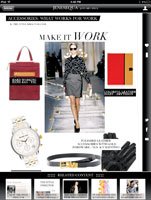TECHNOLOGY
Fashion, Retail Tech Start-ups Hot Ticket for Investment
With companies such as Zulily and Gilt Groupe dominating everything from e-commerce to social media, fashion technology start-ups have never been hotter.
“The apparel and accessories category grew at the highest rate during this year, compared with any other e-commerce category,” said Andy Pandharikar, co-founder and chief executive officer of Fitiquette, a virtual fitting room and shopping site. “That beats [growth in] the sale of books, electronics and other hard goods, which have been considered the most dominant e-commerce sector until this year.”
There are a few forces that have intersected in recent years that are driving this trend, he explained. The increased use of mobile devices, Internet access, social networking and devices with high-resolution cameras—as well as a growing appetite for new business models, including subscriptions and flash sales—have all contributed to a fashion technology boom.
Zulily—the flash-sale site dedicated to clothing for moms, infants and children— raised $43 million from Meritech Capital Partners last year and is reportedly worth more than $700 million. The company was named by Business Insider as one of Seattle’s top 14 start-ups to watch. According to a recent Wall Street Journal article, the wildly popular lifestyle website Pinterest recently raised $100 million in financing and is now worth $1.5 billion.
Female focus
Fritz Lanman, a founding investor in Pinterest and co-founder of JNSQ, a mobile fashion magazine and publishing platform, said the popularity of fashion tech businesses is, in part, due to fashion and apparel representing such a valuable core demographic.
“Women 18 to 50, especially those into luxury, comprise a hugely disproportionate percentage of GDP,” Lanman said.
Laura Moreno, founder and president of Laly Designs, a San Francisco company that sells apparel online and helps designers with social commerce and marketing, also said the female demographic is a driving force.
“There’s always one sector that’s ‘hot’ right now for investors, and I believe it really started with the focus on mom businesses, specifically with the sale of Diapers.com to Amazon. When that occurred, investors started to really take the mom- and female-focused business much more seriously,” Moreno said. “You then saw the infusion of capital into female businesses such as Plum District, KiwiCrate, Citrus Lane, and then into the female fashion business with companies like ModCloth and … Rent the Runway. There’s also a big push in Silicon Valley to invest in more female-run companies.”
Lower start-up costs
Another factor in the explosion of start-ups is the cheaper cost of developing the technology, compared with several years ago.
“The capital needed to start is lower than in the past,” said Enrico Beltramini, a managing partner in Naxuri Capital, an investment firm that helped launch “Ahead of the Fashion,” a program designed to fund and mentor fashion, retail and technology entrepreneurs.
“Now you can develop a mobile application for $10,000 to $50,000.”
Until recently, the branded goods, fashion and retail industries have lagged in technology, said Karen Griffith Gryga, co-founder and CEO of FashInvest, a Philadelphia-based company that brings together investors and entrepreneurs from the fashion and technology sectors.
In 2008, technologists began to work with these industries, and in the past two years things have heated up dramatically, she said.
“The fact that it’s a large market opportunity, that’s what driving the innovation of industry,” Griffith Gryga said. “It’s a huge space where there’s lots of opportunities. … These sectors have finally seen the opportunities, and they are opening their eyes to all of the possibilities—mobile components, social media, highly visual and merchandised experiences that can be seen through an online medium, and all of the new ways of interacting and engaging with a customer.”
Drive to innovate
The recession has also played an important role.
“What the recession did was it made everyone re-evaluate how they traditionally conducted business,” she said. “It was the right timing for flash sales because companies had a lot of excess inventory to get rid of and consumers were having tighter budgets and looking for deals.”
Since then, companies have evolved their perspectives on flash sales. “Rue La La filled up with so many members that it became a branding platform for certain brands. It became a platform to market to potential new consumers,” she said.
While there are some concerns of over-saturation and too many “me-too’s” (companies that repeat existing technologies rather than developing something new), many in the industry agree that there is still massive opportunity and that the market is not fully developed.
“This is an emerging field in the U.S., so it still has a long way to go,” said Kathleen Allen, a professor of clinical entrepreneurship and director of the University of Southern California’s Marshall Center for Technology Commercialization. “It will be a while before we have mass adoption of mobile apps in retail, but the more traditional e-commerce sites are more mature now, and there has been some shakeout, leaving some pretty huge dominant players like Amazon that are stepping into a variety of industries, including fashion.”
Further growth and opportunities
According to a report by the online-marketing research firm eMarketer, the apparel and accessories category of e-commerce is expected to grow by 20 percent to $40.9 billion this year.
“There are many verticals within the space that offer companies the chance to play a huge role selectively,” noted a spokesperson from Zulily. “It’s also an ever-changing and expanding market—new labels, designers, trends waiting to be discovered.”
Grifith Gryga said the opportunities for the market are “humungous,” especially in specific subsegments, such as mobile shopping and social shopping (when shoppers connect with physical or virtual friends to have interaction and feedback while shopping).
Fitiquette’s Pandharikar agreed.
“We believe the fashion tech sector will continue to grow faster than ever before. It won’t be a surprise, given the forces at play, to see new start-ups replacing incumbent fashion companies in the near future.”
Financing checklist
With the explosion of start-ups in the fashion industry, there has also been an increase in financing, but there are a few key elements that investors expect before they’re willing to make an investment.
“For most investors, the founding team is critical. If the team doesn’t have the talent to execute the business, it will be difficult to attract investors,” Allen said. “Beyond that, investors want to know that you’re solving a compelling problem in a growing market, that you’re not just another ‘me-too’ offering. This is particularly important now, with so many start-ups trying to get into the game.”
Investors also want scale, according to Jeff Beam, founder and chief executive officer of Clikthrough, a taggable-video technology used by many apparel companies.
“They like seeing a winning business and being associated with growing trends. It’s all about the product and the traction,” he said.
“They like when you have current customers that want more of your service and whatever you’re doing. It’s better if you’ve already built the product and are looking to grow it, as opposed to if you haven’t built it yet—if you’re trying to scale an operation that you’re already running, that’s already successful.”
In addition to having a team with industry experience and solving a problem for a large market, having an entrepreneurial mindset is crucial, Griffith Gryga said.
“One of the most important elements of an entrepreneur is to take feedback and iterate— you have to be nimble and keep iterating until you figure out which formula is the right formula,” she said.
One bonus to the investor community is the drive to work together to increase capital, according to JNSQ’s Lanman.
“Angel [investors] are extremely collaborative with one another because that maximizes their deal flow, so they will almost certainly be able to route start-ups to investors they think are a good match.”
Red flags that can turn investors away include entrepreneurs who are not coachable, as well as a high burn rate, when a start-up has continually been burning through cash and yet still doesn’t have its product figured out.
“The relationship with the investor is a partnership; it’s not an adversarial relationship,” Griffith Gryga said. “Investors invest because they believe in the team and the opportunity and a long-term partnership, and the entrepreneur has to be coachable. [The investors] have seen similar situations from their portfolio and need to be able to give feedback.”
























